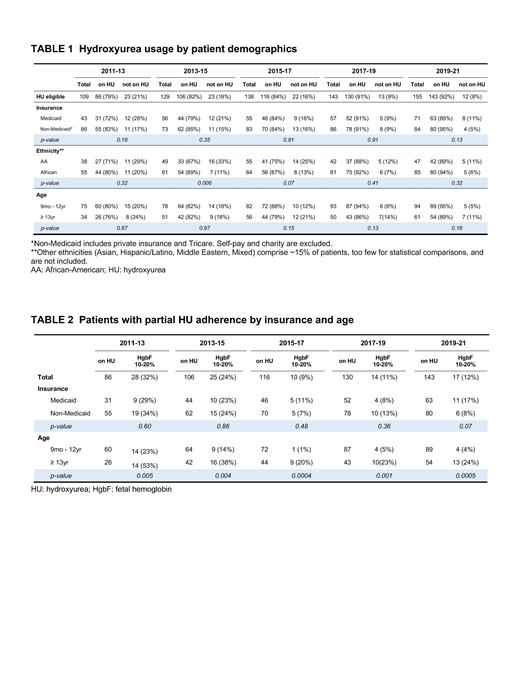Introduction/Background:
Hydroxyurea is highly effective in sickle cell disease, yet it is still underutilized. The Pediatric Sickle Cell Program of Northern Virginia recently published a 10-year analysis of uniform hydroxyurea (HU) implementation starting in infancy for all patients with sickle cell disease of severe genotype (SCA), demonstrating rise in HU usage from 32.5% baseline rate to 79.6% after two years, and to > 90% after 8 years. 1 Other HU utilization studies reporting lower rates largely use Medicaid data, and lower socioeconomics is often cited as a barrier to HU utilization. The Northern Virginia study reported on all patients with SCA regardless of insurance coverage, thus raising the question whether the high HU usage rate achieved in this program was influenced by a high proportion of non-Medicaid patients or other unusual demographic features. Therefore, we analyzed 10 years of HU usage data by insurance, ethnicity, and age.
Methods:
HUdata extracted from a longitudinal REDCap database and electronic medical records (EMR) with IRB approval (Children's National Medical Center IRB, Pro00002745, Pro00013374) previously reported 1 for five 2-year intervals are additionally analyzed for insurance, ethnicity, and age, with new data for 2019-2021. HU-eligibility includes SCA patients age ≥ 9 months and not chronically transfused. HU users (on HU) are patients demonstrating Hgb F rise and expected hemogram changes in response to HU, monitored every 2-3 months; HU non-users (not on HU) are patients who refuse HU or are grossly non-adherent as evidenced by lack of changes in Hgb F and hemogram. Pharmacy dispense records available in Epic EMR are used as corroborative information.
Results:
1. Medicaid patients comprised 39 - 46% and non-Medicaid patients comprised 54 - 61% of all patients over the five 2-year periods. African-American (AA) and African patients comprised 85% of all patients. Medicaid coverage ranged from 24 - 39% for AA patients and 38 - 48% for African patients. (African is defined as born in Africa or having parents born in Africa who immigrated to the US.)
2. Comparing HU usage by insurance over the five 2-year periods, HU users increased from 72% to 91% for Medicaid patients and from 83% to 95% for non-Medicaid patients. Conversely, HU non-users decreased from 28% to 9% for Medicaid patients and from 17% to 5% for non-Medicaid patients. No statistical difference was detected in HU usage by Medicaid versus non-Medicaid insurance in any interval (p = 0.13 to 0.91) (Table 1).
3. HU usage rates in AA and African patients were not statistically different (p = 0.07 to 0.32), except in one interval (2013-15) (p = 0.006) (Table 1).
4. Comparison of HU usage in two age groups, 9 months-12 years and ≥ 13 years, showed that while HU non-acceptance/non-adherence tended to be higher in the age ≥ 13 group, no statistical significance was reached in any interval (p = 0.13 to 0.97) (Table 1).
5. The uniform HU implementation program targeted for fetal hemoglobin (Hgb F) 30% or higher by frequent HU dose optimization and close adherence monitoring. Hgb F > 20% was considered good adherence, and Hgb F 10-20% reflected partial adherence. Partially adherent patients did not distribute differently between Medicaid and non-Medicaid insurance (p = 0.07 to 0.86) but were predominantly age > 13 (p = 0.0005 to 0.001) (Table 2).
Conclusion:
1. HU users and HU non-users did not disproportionately distribute to any demographic group.
2. Uniform HU implementation was effective in both Medicaid and non-Medicaid populations.
3. Ethnicity and age were not significant factors in HU uptake or acceptance, but decreased HU adherence is more frequent in teenagers.
4. HU can be effectively implemented for all SCA patients across demographic groups. Medicaid insurance, as a proxy for socioeconomic level, is not a barrier to high HU usage.
Reference:
1. Phan V, Park JA, Dulman R, Lewis A, Briere N, Notarangelo B, Yang E. Ten-year longitudinal analysis of hydroxyurea implementation in a pediatric sickle cell program. Eur J Haematol. 2022 Nov;109(5):465-473. doi: 10.1111/ejh.13827. Epub 2022 Sep 2. PMID: 35811388.
Disclosures
Dulman:Pfizer: Current holder of stock options in a privately-held company.


This feature is available to Subscribers Only
Sign In or Create an Account Close Modal